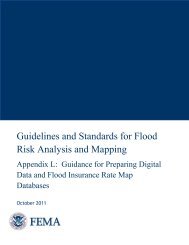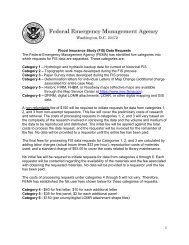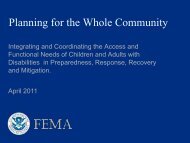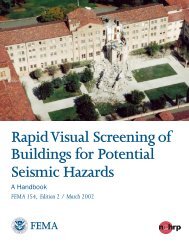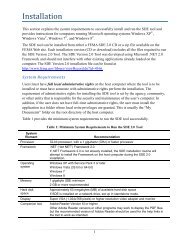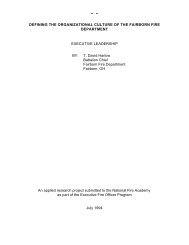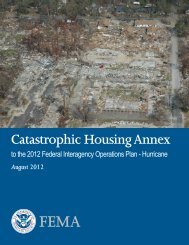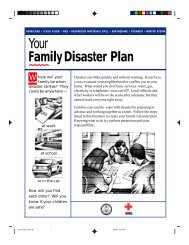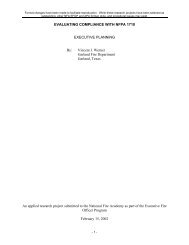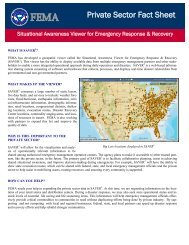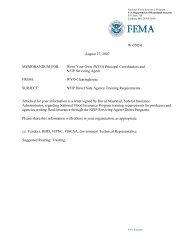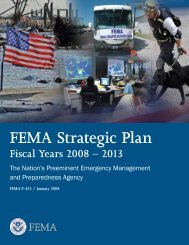Joint Field Office Activation and Operations - Federal Emergency ...
Joint Field Office Activation and Operations - Federal Emergency ...
Joint Field Office Activation and Operations - Federal Emergency ...
Create successful ePaper yourself
Turn your PDF publications into a flip-book with our unique Google optimized e-Paper software.
UNCLASSIFIEDAnnex C: <strong>Operations</strong>1.0 Principles for Building Interagency CoordinationInteragency coordination <strong>and</strong> cooperation is critical to effective <strong>and</strong> efficient operations topreempt or mitigate natural or man-made disasters. It is imperative that representatives ofagencies with diverse capabilities synchronize their efforts through the application of basicteaming principles. These principles, shown below, support a systematic methodology towardbuilding a homogeneous effort at all levels of government.1.1 Define the Problem in Clear <strong>and</strong> Unambiguous Terms Agreed toby AllDifferences in individual assumptions <strong>and</strong> organizational perspectives can often limit clearunderst<strong>and</strong>ing of the problem. Representatives from each major group of agencies,departments, <strong>and</strong> organizations—to include the on-scene Incident Comm<strong>and</strong> agencies—should be involved in all levels of coordination planning from the outset. Theserepresentatives are especially important in order to achieve unity of effort during thisproblem definition phase; early development of options for interagency consideration is veryimportant. Not all agencies <strong>and</strong> individuals clearly distinguish in the same way betweenwide-area operational coordination <strong>and</strong> incident comm<strong>and</strong>-<strong>and</strong>-control or oversight.Defining the problem that the JFO solves should involve extensive focus on the differencebetween wide-area operational coordination <strong>and</strong> comm<strong>and</strong>-<strong>and</strong>-control over the incidentitself.1.2 Define the ObjectivesWithin the context of interagency operations, decision makers in the JFO CoordinationGroup should seek clearly defined <strong>and</strong> attainable objectives, a concrete end state, <strong>and</strong> exitcriteria. Successful interagency coordination is essential to achieve these goals <strong>and</strong> thedevelopment of accurate <strong>and</strong> timely assessments. Such definition allows application ofresources of the most appropriate agency(s). Not all agencies will necessarily underst<strong>and</strong> oragree to the need to clearly define the objective with urgency or specificity. Complicationscan arise because each agency has its own perspective, capabilities, <strong>and</strong> culture. Thisdiversity is the strength <strong>and</strong> not the weakness of the interagency coordination process. Whilethere may be disagreement about solutions, the differences provide a broad range of optionsthat can be applied.1.3 <strong>Operations</strong> Drive at Tactical Level; Logistics, Situation, <strong>and</strong>Planning Drive at Strategic LevelAt the field or tactical level, an Incident Comm<strong>and</strong> surges in as operations are alreadyoccurring; everything in the Incident Comm<strong>and</strong> serves to support operations. At the strategiclevel, coordination of operations typically follows in-depth development of the situation inthe “wide area,” answering of requests for logistics support, <strong>and</strong> digestion/consolidation of23Version 8.3Interim Approval April 28, 2006



